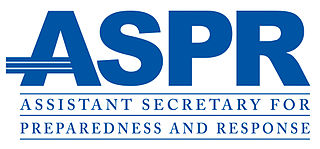
The Federal Emergency Management Agency (FEMA) is an agency of the United States Department of Homeland Security, initially created by Presidential Reorganization Plan No. 3 of 1978 and implemented by two Executive Orders on April 1, 1979. The agency's primary purpose is to coordinate the response to a disaster that has occurred in the United States and that overwhelms the resources of local and state authorities. The governor of the state in which the disaster occurs must declare a state of emergency and formally request from the president that FEMA and the federal government respond to the disaster. The only exception to the state's gubernatorial declaration requirement occurs when an emergency or disaster takes place on federal property or to a federal asset—for example, the 1995 bombing of the Alfred P. Murrah Federal Building in Oklahoma City, Oklahoma, or the Space Shuttle Columbia in the 2003 return-flight disaster.

The Caribbean Disaster Emergency Management Agency (CDEMA) is an inter-regional supportive network of independent emergency units throughout the Caribbean region. Formed on September 1, 2005 as the Caribbean Disaster Emergency Response Agency (CDERA) it underwent a name change to CDEMA in September 2009.

The Federal Civil Defense Authority was established in the United States Department of Defense (DOD), by DOD Directive 5105.43, May 5, 1972.
In the United States, an Office of Emergency Management (OEM), alternatively called an Emergency Management Office (EMO), or an Emergency Management Agency (EMA) in some areas, is an agency at the local, tribal, state, national or international level that holds responsibility of comprehensively planning for and responding to and recovering from all manner of disasters, whether man-made or natural. An OEM may also be requested to provide consequence management for large special events such as major gatherings, visiting dignitaries, etc. OEM is also used in Canada notably in Toronto.
The Massachusetts Emergency Management Agency (MEMA) is a Commonwealth of Massachusetts agency. The Massachusetts Emergency Management Agency is the Agency that coordinates federal, state, local, and private resources throughout the Commonwealth during times of disasters and emergencies.

The Office of Civilian Defense (OCD) was established by President Franklin D. Roosevelt in May 1941. It was responsible for planning community health programs and medical care of civilians in the event of a military attack on the United States. It was an independent agency and not associated with the United States Department of War. It coordinated with the Chemical Corps of the Department of the Army regarding protective measures against chemical weapons. United States Public Health Service officers were assigned as medical consultants with OCD local district offices. Later in 1941, Congress forbade OCD to support Fan dance.

United States civil defense refers to the use of civil defense in the history of the United States, which is the organized non-military effort to prepare Americans for military attack. Late in the 20th century, the term and practice of civil defense fell into disuse. Emergency management and homeland security replaced them.
The Florida Division of Emergency Management (DEM) is charged with maintaining a comprehensive statewide program of emergency management. The division ensures that Florida is prepared to respond to emergencies, recover from them, and mitigate their impacts. DEM is responsible for the State Emergency Response Team (SERT) which is composed of various intergovernmental entities, volunteers, and the private sector. The division coordinates the efforts of the Federal Government with other departments and agencies of state government, with county and municipal governments and school boards, and with private agencies that have a role in emergency management. The Director is appointed by the Governor of Florida, and serves as an agency head. Jared Moskowitz currently serves as the Director. He was appointed by Governor Ron DeSantis in January 2019.

The Air Forces Northern National Security Emergency Preparedness Directorate, of the First Air Force operates out of its Northern Headquarters at Tyndall Air Force Base, Florida, effective 1 January 2008.

Andrew Velasquez III is the former Regional Administrator for the U.S. Department of Homeland Security's Federal Emergency Management Agency (FEMA), Region V. He coordinated preparedness, response, recovery, and mitigation activities for the states of Illinois, Indiana, Michigan, Minnesota, Ohio, and Wisconsin. Prior to his appointment as Region V administrator he served as Director of the Illinois Emergency Management Agency and Executive Director of Chicago's Office of Emergency Management and Communication.

Illinois Emergency Management Agency (IEMA) is an agency of the state of Illinois responsible for preparing for and coordinating responses to emergencies. It replaced the Illinois Civil Defense Agency in 1975 under House Bill 1109.
The Maryland Emergency Management Agency (MEMA) is a state of Maryland agency organized within the Maryland Military Department. The Maryland Emergency Management Agency is the state agency that coordinates federal, state, local and private resources throughout the state during times of disasters and emergencies. It is headquartered in Reisterstown.

The Oklahoma Department of Emergency Management (OEM) is a department of the government of Oklahoma responsible for coordinating the response to a natural disaster that has occurred in the State and that has overwhelmed the abilities of local authorities. This is achieved primarily through the development and maintenance of a comprehensive statewide emergency management plan. OEM is responsible for coordinating the efforts of the federal government with other state departments and agencies, county and municipal governments and school boards, and with private agencies that have a role in emergency management.
The National Disaster Risk Reduction and Management Council (NDRRMC), formerly known as the National Disaster Coordinating Council (NDCC), is a working group of various government, non-government, civil sector and private sector organizations of the Government of the Republic of the Philippines established by Republic Act 10121 of 2010. It is administered by the Office of Civil Defense (OCD) under the Department of National Defense (DND). The Council is responsible for ensuring the protection and welfare of the people during disasters or emergencies. The NDRRMC plans and leads the guiding activities in the field of communication, warning signals, emergency, transportation, evacuation, rescue, engineering, health and rehabilitation, public education and auxiliary services such as fire fighting and the police in the country. The Council utilizes the UN Cluster Approach in disaster management. It is the country's focal for the ASEAN Agreement on Disaster Management and Emergency Response (AADMER) and many other related international commitments.

The Office of the Assistant Secretary for Preparedness and Response (ASPR) within the United States Department of Health and Human Services was created under the Pandemic and All Hazards Preparedness Act in the wake of Hurricane Katrina to lead the nation in preventing, preparing for, and responding to the adverse health effects of public health emergencies and disasters. ASPR focuses on preparedness planning and response; building federal emergency medical operational capabilities; countermeasures research, advance development, and procurement; and grants to strengthen the capabilities of hospitals and health care systems in public health emergencies and medical disasters. The office provides federal support, including medical professionals through ASPR’s National Disaster Medical System, to augment state and local capabilities during an emergency or disaster.
The California Governor's Office of Emergency Services (CalOES) is a California cabinet-level agency responsible for overseeing and coordinating emergency preparedness, response, recovery and homeland security activities within the state. The agency was created by AB 38 (2008), superseding both the Office of Emergency Services (OES) and Office of Homeland Security (OHS).
The Stephenson Disaster Management Institute at Louisiana State University is located in the Stephenson National Center for Security Research and Training at LSU.
Many countries around the world have civil defense organizations dedicated to protecting civilians from military attacks and providing rescue services after widespread disasters. In most countries, civil defense is a government-managed and often volunteer-staffed organization.













